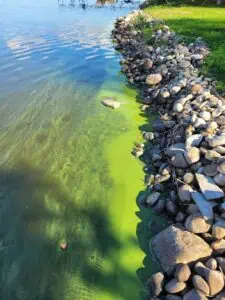
If you have ever gone to a lake, river, or pond, during the spring or summer, there is a good chance that you have seen algae there. Algae, unlike many plants we know, are simple plants with no true roots, leaves or stem systems. It is typically green, slimy, and found atop of water. The presence of algae is identifiable through a subtle greenish color creeping across lakes or ponds. Most species of algae can be helpful to the environment, while others can be harmful, toxic, and cause illnesses. It is important to know the difference between the two so that we can work towards improving, conserving, and cleaning up our marine environments.
There are many benefits to having algae in bodies of water. Similarly to many plants, algae contain Chlorophyll (a green pigment), and through the process of photosynthesis, algae help purify the air and water by releasing oxygen.
According to britannica.com, “Algae provides much of Earth’s oxygen, serves as the food base for almost all aquatic life, and provides foods and industrial products, including petroleum products.” A specific kind of algae, Spirulina, is edible, and considered to be highly nutritious and beneficial to your health.
While algae can have many benefits, some types of algae are harmful to marine environments. This algae is visible through abnormal water coloration that can appear blue-green, red, or brown. Harmful algae have musty, rotting smells, whereas normal algae have more of a neutral scent. An example of this is Red tide, which is scientifically known as Karenia brevis, a toxic species of algae that has a red pigment. This algae can cause coughing, sneezing, and teary eyes amongst humans, and lack of oxygen and death in marine ecosystems.
Algae becomes dangerous when it produces harmful algal blooms that contain toxins. They can be a silent killer that can upset the delicate balance of our ecosystems with serious consequences. The National Institute of Environmental Health Sciences (NIEHS), niehs.nih.gov, defines harmful algal blooms as “When toxin-producing algae grows excessively in a body of water.” “Scientists know that certain environmental conditions, such as warmer water temperatures in the summer, and excessive nutrients from fertilizer, or sewage wastes brought by runoff, triggers Harmful algal blooms, but they are still learning more,” says experts at the NIEHS.
While Harmful algal blooms can harm marine environments, they also do damage to fishing industries, which can have devastating economic impacts on local communities due to changes in diets, income, and food security. People can be exposed to these toxins through the consumption of contaminated fish or water.
The NIEHS describes the release of algae toxins as “When toxin-producing algae release toxins into the surrounding water or air that can seriously harm people, animals, fish, and other parts of the ecosystem.” Consumption of toxic algae can result in serious illnesses, and in rare instances, death. Fishing Industries in impacted areas need to be well-monitored to prevent contamination. “More than 50% of unusual marine mortality events, also known as UMEs, are now associated with Harmful algal blooms,” according to the U.S. National Office for Harmful Algal Blooms (NOHAB).
While there is damage to the environment due to Harmful algal blooms, there are ways they can be prevented.
According to NOHAB, using clay as a physical control method for algal blooms can work effectively. “When sprinkled on surface waters during an algal bloom, the tiny but dense clay particles will ‘flocculate’; or combine with other particles in the water, including the Harmful algal bloom cells.” Through this process, the clay is able to latch onto algae cells, sink them underwater, and kill them.
The CDC states, “Using the recommended amounts of fertilizers on farms, yards, and gardens [will help]. This will reduce the amount of nutrients running off into nearby water bodies.” This could help prevent algal blooms as well.
Preventive measures can be taken to stop or reduce the impact of algae blooms. There is a great need to invest in earlier warning systems to detect the algal blooms before they occur. It is necessary to increase public awareness of the dangers and risks of consuming or being exposed to toxic algae.
Knowing the differences between both harmful and normal types of algae is important. Next time you see a body of algae on water, remember that there are organisms, such as algae, that have both positive and negative impacts on our environment. If you do not know which one you are dealing with, it is best to keep a safe distance from them.













